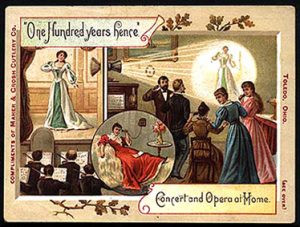
Who and When Was Television Invented?
The invention of television, a groundbreaking moment in communication history, wasn’t a single event but a culmination of efforts by numerous scientists and inventors spanning decades. While pinpointing the exact “who” and “when” can be complex, this article delves into the key figures and milestones that led to the television we know today.
The Early Days of Television: A Collaborative Effort
The seeds of television were sown in the late 19th and early 20th centuries, with visionaries like Jules Verne and H.G. Wells imagining “seeing at a distance.” Scientists worldwide raced to turn this dream into reality. In the 1920s, figures like Charles Francis Jenkins in America and John Logie Baird in Scotland developed mechanical television systems, transmitting rudimentary images. Jenkins’ “radiovision,” though blurry and slow, correctly predicted the future of televised events.
An 1890s trading card depicting an early vision of “home theater,” showcasing the public’s fascination with the possibility of television.
Philo Farnsworth: The Father of Electronic Television
While mechanical systems offered a glimpse into the future, the true breakthrough came with electronic television. In 1927, a 21-year-old American inventor, Philo Taylor Farnsworth, developed the “image dissector,” the first functioning electronic camera tube. This invention revolutionized the technology, paving the way for clearer and more reliable image transmission.
The Rise of Electronic Television and the RCA Connection
Farnsworth’s invention caught the attention of David Sarnoff, president of the Radio Corporation of America (RCA). RCA’s engineer, Vladimir Zworykin, developed the “iconoscope,” a device strikingly similar to Farnsworth’s image dissector, leading to a protracted patent dispute. Ultimately, RCA acknowledged Farnsworth’s crucial contribution and paid him royalties.
A newspaper clipping announcing the transmission of Herbert Hoover’s image, highlighting a significant milestone in early television development.
From Experimentation to Mass Adoption: The 1930s and Beyond
The 1930s witnessed the emergence of experimental television broadcasts, with networks like NBC and CBS establishing stations. World War II temporarily halted progress, but the post-war era saw television’s meteoric rise. By the 1950s, television had supplanted radio as the dominant medium, transforming entertainment and information dissemination forever.
A 1928 Popular Mechanics magazine cover featuring television, indicating the growing public interest and anticipation surrounding this new technology.
Conclusion: A Legacy of Innovation
The invention of television was a collaborative process, with numerous individuals contributing to its development. However, Philo Farnsworth’s invention of the electronic camera tube stands out as the pivotal moment. From its humble beginnings to its current ubiquitous presence, television’s journey is a testament to human ingenuity and the relentless pursuit of technological advancement. The development of television dramatically changed the landscape of communication and entertainment, influencing global culture in profound ways.
